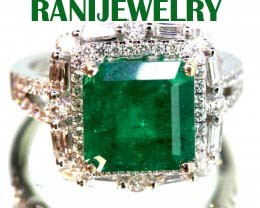602CTS AUSTRLIAN EMERALD QUALITY SPECIMEN TBM-2320
- SKU
- Dimensions (mm)
- 65.000 x 52.000 x 36.000mm
- Weight (cts)
- 602.000
- Colours
-
AUSTRALIAN EMERALD
Curlew Emerald Mine, Shaw River District, East Pilbara Shire, Western Australia, Australia
STUNNING SPECIMEN
TREATMENT -NONE
COLLECTOR PC
GREEN-CRYSTAL
HAS PURPLE FLOURITE INCLUSION
ON HOST ROCK
Specimens can consist Light green beryl crystals to green beryl coloration, with minor dark biotite specks mica ,schist and purple fluorite inclusions.
The dark mica schists within the quartz veins and pegmatites contain gem quality emerald crystals and green beryl. As is typical of Western Australian emerald
Curlew Emerald Mine, Shaw River District, East Pilbara Shire, Western Australia, Australia
Nearly all production of emerald in Western Australia has been from a deposit at Poona but there are beryl and emerald deposits at Menzies and in the Pilbara region, south of Port Hedland.
Emeralds have been commercially mined in Australia in three main deposits Poona and Menzies in Western Australia, and Emmaville in New South Wales. The emeralds are usually in rocks among layers of other minerals such as mica. Open pit mining or terrace mining are the most common methods.discovered in Western Australia in 1912 at Poona, 500 km north-east of Perth. The main mine of the district was the Aga Khan which operated on and off for more than 70 years until 1980 and yielded an estimated 10,000 grams of mostly low value emerald. During the1980s another mine in WA was worked some 40kms west of Menzies.
In Australia, emerald is associated with granite pegmatites and metamorphosed rocks called schists. It is also sometimes associated with altered limestones or can be found embedded in calcite or quartz. A pegmatite forms when a magma cools, leaving some elements behind in the remaining fluid. Emerald crystals may grow when the remaining solution cools as long as the necessary elements are present, including beryllium. Emeralds can also form in veins in the crust from hot liquids that escape from a deeper magma.
Processing
Screens are used to sort the emeralds by size and then silt and clays are washed away to expose the emerald-bearing schist. No other chemicals are used in this process. Any schist or other rock still attached to the emerald is removed manually in a process called cobbing. Higher quality materials can be cleaned using high-pressure air.
Mining
Emeralds have been commercially mined in Australia in three main deposits Poona and Menzies in Western Australia, and Emmaville in New South Wales. The emeralds are usually in rocks among layers of other minerals such as mica. Open pit mining or terrace mining are the most common methods. Miners dig a pit with shovels, excavators or other earth moving equipment, depending on the scale of the mine. If the emerald-bearing ore is beneath a substantial cover of soil and rock, explosives might be used to remove this material. Sometimes high pressure water is used to blast the rock to reveal mineral bearing rocks. Tunnels are also used to extract emeralds from deeper rock layers.
Beryl Be3Al2(Si6O18) , Biotite K(Fe2+/Mg)2(Al/Fe3+/Mg/Ti)([Si/Al/Fe]2Si2O10)(OH/F)2 or Simplified: K(Mg,Fe)3AlSi3O10(OH)2 , Quartz SiO2
- SKU
- Dimensions (mm)
- 65.000 x 52.000 x 36.000 mm
- Weight (cts)
- 602.000
- Colours
-
AUSTRALIAN EMERALD
Curlew Emerald Mine, Shaw River District, East Pilbara Shire, Western Australia, Australia
STUNNING SPECIMEN
TREATMENT -NONE
COLLECTOR PC
GREEN-CRYSTAL
HAS PURPLE FLOURITE INCLUSION
ON HOST ROCK
Specimens can consist Light green beryl crystals to green beryl coloration, with minor dark biotite specks mica ,schist and purple fluorite inclusions.
The dark mica schists within the quartz veins and pegmatites contain gem quality emerald crystals and green beryl. As is typical of Western Australian emerald
Curlew Emerald Mine, Shaw River District, East Pilbara Shire, Western Australia, Australia
Nearly all production of emerald in Western Australia has been from a deposit at Poona but there are beryl and emerald deposits at Menzies and in the Pilbara region, south of Port Hedland.
Emeralds have been commercially mined in Australia in three main deposits Poona and Menzies in Western Australia, and Emmaville in New South Wales. The emeralds are usually in rocks among layers of other minerals such as mica. Open pit mining or terrace mining are the most common methods.discovered in Western Australia in 1912 at Poona, 500 km north-east of Perth. The main mine of the district was the Aga Khan which operated on and off for more than 70 years until 1980 and yielded an estimated 10,000 grams of mostly low value emerald. During the1980s another mine in WA was worked some 40kms west of Menzies.
In Australia, emerald is associated with granite pegmatites and metamorphosed rocks called schists. It is also sometimes associated with altered limestones or can be found embedded in calcite or quartz. A pegmatite forms when a magma cools, leaving some elements behind in the remaining fluid. Emerald crystals may grow when the remaining solution cools as long as the necessary elements are present, including beryllium. Emeralds can also form in veins in the crust from hot liquids that escape from a deeper magma.
Processing
Screens are used to sort the emeralds by size and then silt and clays are washed away to expose the emerald-bearing schist. No other chemicals are used in this process. Any schist or other rock still attached to the emerald is removed manually in a process called cobbing. Higher quality materials can be cleaned using high-pressure air.
Mining
Emeralds have been commercially mined in Australia in three main deposits Poona and Menzies in Western Australia, and Emmaville in New South Wales. The emeralds are usually in rocks among layers of other minerals such as mica. Open pit mining or terrace mining are the most common methods. Miners dig a pit with shovels, excavators or other earth moving equipment, depending on the scale of the mine. If the emerald-bearing ore is beneath a substantial cover of soil and rock, explosives might be used to remove this material. Sometimes high pressure water is used to blast the rock to reveal mineral bearing rocks. Tunnels are also used to extract emeralds from deeper rock layers.
Beryl Be3Al2(Si6O18) , Biotite K(Fe2+/Mg)2(Al/Fe3+/Mg/Ti)([Si/Al/Fe]2Si2O10)(OH/F)2 or Simplified: K(Mg,Fe)3AlSi3O10(OH)2 , Quartz SiO2
| Shipping provider | Shipping to Australia | Shipping to rest of world |
|---|---|---|
| Standard Shipping - Tracked | $17.00 / 7 days | $30.00 / 14 days |
|
Australia
Standard Shipping - Tracked is discounted to $20.00 on orders with 2 or more items
Rest of the world
Standard Shipping - Tracked is discounted to $30.00 on orders with 2 or more items
|
||
| FedEx | $35.00 / 3 days | $35.00 / 7 days |
|
Australia
FedEx is discounted to $35.00 on orders with 2 or more items
Rest of the world
FedEx is discounted to $35.00 on orders with 2 or more items
|
||

best price offered-purchased direct from source.
-
 Positive
PositiveNice and shiny thanks
-
 Positive
PositiveFantastic thanks
-
 Positive
PositiveGood material thanks
-
 Positive
PositiveWill be fantastic once fully finished
-
 Positive
PositiveNice trio




















